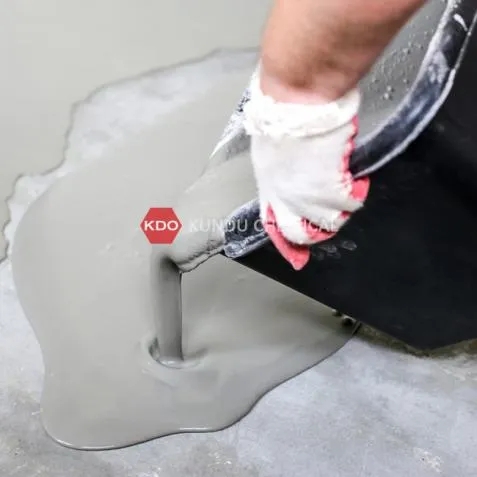- Time:2024/6/13Posted:SHANDONG KUNDU CHEMICAL CO.,LTD.
Water reducing agent can improve the flow properties of gypsum slurry, or reduce the water consumption of standard consistency and improve the strength and surface hardness of gypsum hardened body while maintaining the same flow properties of gypsum slurry.
Melamine water-reducing agents (melamine) have obvious water-reducing and enhancing effects on gypsum based materials. This type of water-reducing agent is white or light-colored powder, which does not affect the color of gypsum and can effectively reduce the plastic viscosity of gypsum slurry. Naphthalene-based high-efficiency water-reducing agents and sulfonamide-based water-reducing agents commonly used in concrete are often used to increase the fluidity of gypsum due to their low prices. However, the strength increase is not as good as that of melamine-based water-reducing agents and will affect the color of gypsum.
Melamine water-reducing agents generally have a water-reducing effect on most gypsum based materials (α and β gypsum, natural and chemical gypsum), and can be combined with other admixtures (such as retarder, accelerator, water retaining agent, Defoaming agent, etc.) has good compatibility. The dosage of this water-reducing agent is generally 0.5% to 1.5%, the water-reducing rate is 20% to 40%, and the strength is increased by 30% to 60%. Melamine-based high-efficiency water-reducing agent can also be combined with an appropriate amount of cheap additives such as molasses, Calcium sugar, sodium gluconate, etc. are used in combination.

What is the mechanism of action of composite water reducing agent in gypsum?
Answer: The organic surface active substances in the composite water reducing agent have a strong dispersing effect on gypsum. It does not react chemically with gypsum itself. It mainly has the function of directional adsorption, reducing the amount of mixing water, improving its pore structure, increasing density, and increasing the flexural strength and compressive strength of the hardened body. In addition, organic surface active substances can also change the hydration process of gypsum and promote the growth of hydrated mineral crystals. However, when the dosage is too large, organic surface-active substances will play an air-entraining role in the slurry.
When using the composite water-reducing agent, fly ash is added to fill the gypsum. Its smooth surface, hard and dense small granular minerals can play the role of "rolling balls" between the gypsum particles, improving the fluidity of the gypsum mixture. Release the water originally filled between the gypsum particles to achieve the purpose of water reduction. If fly ash is used in combination with organic surfactants, the surface of the fly ash particles will inevitably adsorb the organic surfactants, which will deflocculate the fly ash flocs, thereby releasing free water and also reducing water. .
What are the modification effects of different types of water reducing agents on building gypsum?
Answer: The use of water reducing agents is an important way to improve the performance of gypsum-based materials. Adding a water-reducing agent can improve the fluidity of the gypsum slurry while keeping the water-to-paste ratio unchanged; or reduce the water demand while maintaining the fluidity to improve the strength of the gypsum hardened body. There are three categories of commonly used gypsum water-reducing agents: FDN-type naphthalene-based water-reducing agents, whose main ingredients are naphthalene sulfonate formaldehyde condensate and SM type (melamine resin-based water-reducing agent), whose main ingredients are melamine sulfonate formaldehyde condensation. and polycarboxylic acid-based water reducing agent (PCA).
Naphthalene-based water-reducing agent is currently the most widely used high-efficiency water-reducing agent in China. The main products include FDN, NF, UNF, etc. Its molecular structure contains benzene rings and sulfonic acid groups, which has a strong dispersion effect, a high water reduction rate, no retardation, and low air entrainment, making it easy for the gypsum particles to slide between each other, thereby reducing the water required for mixing. Enhance the compactness of gypsum hydrate and improve the strength of gypsum hardened body.
Melamine is also an anionic surfactant. Its performance is close to that of the naphthalene series, but its water reducing and strengthening effects are better than that of the naphthalene series water reducing agent. The addition of water reducing agent reduces the water requirement of standard consistency, so that the porosity formed by water evaporation after gypsum crystallization will be reduced, resulting in an increase in density, thus improving strength; on the other hand, SM water reducing agents improve the gypsum crystal The crystallization properties of the gypsum hardened body increase the number of nodes and the contact points are well developed, and the overlap between the crystals becomes closer, forming a more complete crystal network system, thereby improving the mechanical properties of the hardened gypsum body and increasing its strength.
Polycarboxylic acid-based water-reducing agent is one of the most actively researched high-performance water-reducing agents at home and abroad in recent years, and it is also the leading direction of future water-reducing agent development. Compared with other high-efficiency water-reducing agents, polycarboxylic acid-based water-reducing agents have many different types of active groups on the long main chain of the molecular structure, such as sulfonic acid groups (-SO3H), carboxylic acid groups (-COOH ), hydroxyl group (-OH), polyoxyalkylene group (-(CH2CH2O)m-R), etc. Different groups play different roles: the sulfonic acid group has a good dispersion effect; the carboxylic acid group and hydroxyl group have a retarding effect; the hydroxyl group also has a good penetration and wetting effect, and its dispersion stability is good, and the fluidity is stable. The time loss is smaller than the first two water reducing agents, so it is very suitable for gypsum systems.
In addition, water reducing agents are generally anionic surface-active substances, which in principle have the function of assisting grinding, increasing the specific surface area, refining the particle distribution, and significantly improving the dispersing ability.
What are the main advantages of polycarboxylate superplasticizer?
Answer: Polycarboxylic acid has excellent properties such as high strength, heat resistance, and durability. It is characterized by small slump loss at high temperatures, good fluidity, and no need to significantly increase the amount of water-reducing agent at lower temperatures. Its usual dosage is 0.05% to 0.5%.
Comprehensive comparison, polycarboxylic acid water-reducing agents have the following advantages:
(1) Low dosage and good dispersion performance;
(2) Good slump retention;
(3) When compared under the same fluidity, condensation can be delayed;
(4) There is a large degree of freedom in the molecular structure, many controllable parameters in manufacturing technology, and great potential for high performance;
(5) Formaldehyde is not used in the synthesis, so it does not cause pollution to the environment;
(6) Good compatibility with other types of admixtures;
(7) Using polycarboxylate water-reducing agents, slag or fly ash can be used to replace plaster of paris, thereby reducing costs.
The increase in the dosage of polycarboxylic acid series water-reducing agent has a dual impact on the strength of gypsum. On the one hand, the addition of polycarboxylic acid series water-reducing agent significantly reduces the water-to-paste ratio, thereby increasing the strength of gypsum. However, if the dosage is too large, the gypsum strength will be slowly increased. The setting effect will have an adverse effect on the strength of gypsum, especially the early strength. After the dosage exceeds 0.27%, the early strength has a downward trend. When the dosage reaches 0.67%, the gypsum has not yet finally set in 2 hours. The addition of polycarboxylic acid series water-reducing agents has a significant beneficial effect on the absolute dry strength of gypsum. The absolute dry strength generally increases with the increase in the amount of water-reducing agent, and is ultimately equivalent to the strength achieved by SM water-reducing agent.
What effect does the amount of water-reducing agent have on the pore structure of the gypsum hardened substrate?
Answer: (1) The pores in the hardened gypsum body are mainly caused by water evaporation and the air-entraining property of the water-reducing agent, so the pores mainly exist in the form of large pores (>100nm). When the amount of water-reducing agent is too high, the content of super-large pores (>10 μm) will also increase accordingly due to the air-entraining effect of the water-reducing agent.
(2) The porosity and pore size distribution of gypsum hardened body have an important influence on the strength. The strength of gypsum hardened body increases with the decrease of porosity and refinement of pore size.
(3) The water-reducing agent reduces the porosity of the gypsum hardened body, refines the pore size, and narrows the pore size distribution range. That is, the water-reducing agent can effectively improve the pore structure of the gypsum hardened body, which is why the water-reducing agent plays an enhancing role.
(4) As the amount of water-reducing agent increases, the porosity and average pore size both show a downward trend. However, after the amount reaches 1.0%, since the adsorption capacity no longer increases, the porosity increases instead, and the pore size also increases significantly. , especially the rapid increase in super-large pores, and the negative effects of water-reducing agents cannot be ignored.





